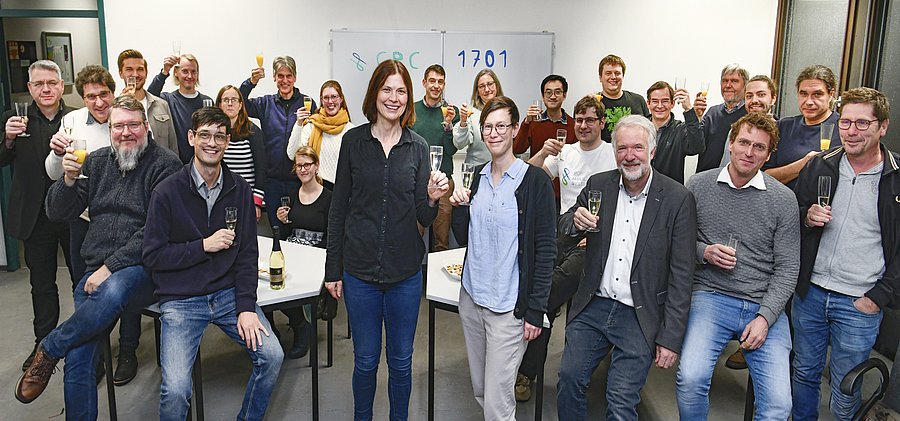New Collaborative Research Centre approved
Paving the way for the future: at the University of Wuppertal scientists are exploring a new approach to mathematical modelling

Great joy about the approved Collaborative Research Centre at the University of Wuppertal: from April 2025, the DFG will be funding the project on Port-Hamiltonian systems led by spokesperson Prof. Dr Birgit Jacob (front, centre left) with 7.7 million euros. More than 20 researchers are involved at the BUW. // Photo Michael Mutzberg
The new Wuppertal Collaborative Research Centre, which the DFG is funding with 7.7 million euros for an initial period of three years and nine months, focuses on ‘Port-Hamiltonian systems’. These represent a new paradigm for particularly powerful mathematical modelling of dynamic systems, i.e. systems that evolve over time. “With our research we do valuable work regarding the application of this paradigm: we wanted to develop a solid mathematical theory for the fundamental processes of Port-Hamilton systems. As a result, it will be possible to understand complex systems better and thus to characterise and predict their properties more precisely, not least with regard to applications,’ summarises Prof Birgit Jacob.
Mathematician Jacob who holds a chair in functional analysis is spokesperson of the Collaborative Research Centre currently including more than 20 employees of the University of Wuppertal alone. Contributions from various mathematical disciplines are required to take full advantage of the mathematical potential of Port-Hamilton systems. With the approval of the DFG Collaborative research centre, the new Port-Hamiltonian Institute at the University of Wuppertal is taking up this interdisciplinary challenge. Representatives from the mathematical disciplines of functional analysis, numerical analysis, stochastics, optimisation and scientific computing are involved. Four scientists from TU Berlin, TU Chemnitz, TU Ilmenau, and Trier University reinforce the Collaborative Research Centre.
„The DFG Collaborative Research Centres represents one of the most important research funding programmes in Germany. The approval that has now been granted is a huge success for the University of Wuppertal. Our mathematicians have been working to make progress for years, establishing themselves and their fundamental research at the forefront of the world and making the University of Wuppertal a centre for Port Hamiltonian systems. They will continue this course in an outstanding research environment, and we will be hearing and reading a lot more from these scientists and their research. The Rectorate sincerely congratulates Prof Jacob and her team”, says Prof Dr Stefan F. Kirsch, Vice-Rector for Research and Digitalization at the University of Wuppertal.
Background: from Hamiltonian to Port-Hamiltonian systems
The Mathematician William Rowan Hamilton developed a method to describe the motion of systems that store energy in different forms, such as a pendulum, which has potential energy, i.e. height, and kinetic energy, i.e. movement. Hamiltonian systems are based on equations that describe how these energies change over time. Port-Hamiltonian systems extend this concept by taking into account the flow of energy between different parts of the system. The term “port”, in this context, means “connection” or “input”, because the concept is about how energy flows in and out of the system’s components. If these ports can be systematically identified and described for the application of a mathematical model, it becomes possible to predict and control the development over time with particular accuracy and in compliance with fundamental physical laws, even in the case of the interaction of two or more systems.
Challenges to which mathematics makes a valuable contribution are many and varied, ranging from climate change over artificial intelligence to the improvement in the quality of life – and this is also the case in the new Collaborative Research Centre. Port Hamiltonian systems are used in mathematics, physics and engineering to describe, simulate and control particularly complex processes. In this case, complexity means that several different physical processes, e.g. mechanical, electrical or thermodynamic ones are involved. “Different systems have to develop over time in a stable manner, even if they are interlinked, so they can function properly as a new overall system. Port-Hamiltonian systems provide a fundamental principle for the mathematical understanding and constitute the basis for the concrete development of solutions”, states Prof Jacob.
One example: in electric cars, various physical phenomena interact, including strong current flows between the battery and motor, electromagnetic radiation during the charging process and heat effects. These phenomena have an impact on the performance, efficiency and reliability of individual components. Port-Hamiltonian systems allow these interactions to be fundamentally modelled, analysed and simulated. In this way, they create the prerequisites for successfully manufacturing specific, functioning and durable components.
At a glance: a new Collaborative Research Centre at the University of Wuppertal
The German Research Foundation (DFG) is establishing a total of seven new Collaborative Research Centres (CRCs), which will be funded from April 2025. More than 20 employees of the University of Wuppertal are currently working at the Collaborative Research Centre Port-Hamilton Systems. They cooperate with other universities as well as with non-university research institutions and industrial partners at national and international level.
More on the topic
How collaboration works: Utilising potential to the full: Port-Hamiltonian Institute founded (Press release dated 13 August 2025)
